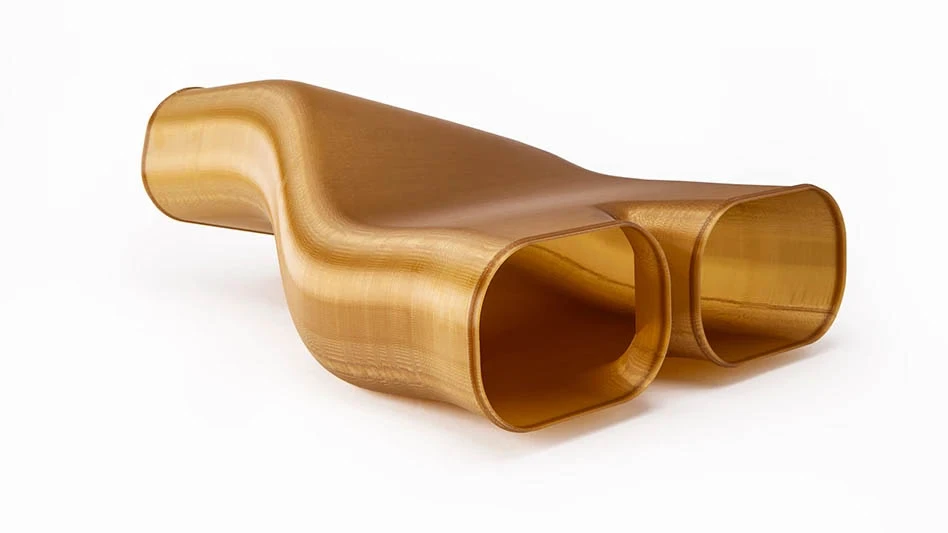 The F-35 Lightning II will be the first mass-produced aircraft to integrate structural nanocomposites in non-load bearing airframe components.Lighter and stronger than ever, the new breed of carbon fiber reinforced plastics (CFRP) and laminates are elevating performance levels in applications ranging from downhill skis and tennis rackets to military aircraft and automobiles. This is because industry says that carbon fiber-reinforced plastics are the best bet for helping manufacturers reach lightweight with strength goals.
The F-35 Lightning II will be the first mass-produced aircraft to integrate structural nanocomposites in non-load bearing airframe components.Lighter and stronger than ever, the new breed of carbon fiber reinforced plastics (CFRP) and laminates are elevating performance levels in applications ranging from downhill skis and tennis rackets to military aircraft and automobiles. This is because industry says that carbon fiber-reinforced plastics are the best bet for helping manufacturers reach lightweight with strength goals.
As a workpiece material, however, their main impact has been to elevate the fabrication challenges, especially machining. While superb in airframes or marine vessel frames – types of fiber-reinforced epoxy, polyester, and vinyl are harder on tools and less forgiving of even small vagaries in processing. Moreover, their higher added-value pre-machining leaves even less tolerance for scrap.
Fortunately, a new generation of cutting tools is emerging, tailored specifically to perform the most frequently required operations on all types of advanced composites. For instance, Iscar's PCD line of drills and milling cutters offers the widest, most proven selection of composite-specific tooling in the industry. There are drills suited for thicker materials with aluminum on the bottom, as well as for thinner materials with the CFRP on the bottom. There are combination drill-countersinks and drill-reamers, slotting cutters, and combination mill/drill cutters. The list goes on. The bottom line is that possibly, for the first time since reinforced composites came on the scene, you can find a no-compromise tool for any conceivable composite machining task.
Presently, the cutting tool materials of choice for composites are CVD diamond-coated carbide inserts, solid carbide endmills, solid carbide drills, and brazed-in PCD inserts or PCD veins at the cutting edge. In literally thousands of applications, on virtually every advanced composite, this type of Iscar tool has outperformed all others. The harder and more highly reinforced the material, the greater the margin of improvement.
The reasons are clear. The solid carbide shank provides the rigidity and dimensional accuracy necessary to maintain close tolerances on size and location, as well as smooth surfaces. Solid carbide also makes it possible to start with an optimal cutting geometry that minimizes cutting forces, heat, uncut fibers, cups, fuzz, and burrs while controlling chips. The CVD-coated inserts provide the wear resistance at the cutting edge to maintain that optimal geometry over long service intervals.
Note the emphasis on CVD diamond coatings. It is possible to coat this on different geometries of inserts with multiple cutting edges. It is also possible to pick a suitable geometry for the application. These inserts will have wear resistance of diamond while preserving the ideal cutting geometry. The multiple cutting edges will help bring down cost per cutting edge.
Whatever the application, there are a few principles to keep in mind when machining CFRPs or other stacked materials.
Holemaking, Close Up
 Iscar’s PCD line of drills and milling cutters offers a wide selection of composite-specific tooling in the industry.Holemaking, mainly for rivet holes, is a mainstay process in composites work, and very unforgiving. Because of their inherent hardness and dimensional stability, CFRP composites do not readily resolve misalignment stresses introduced during fabrication by off-center rivet holes.
Iscar’s PCD line of drills and milling cutters offers a wide selection of composite-specific tooling in the industry.Holemaking, mainly for rivet holes, is a mainstay process in composites work, and very unforgiving. Because of their inherent hardness and dimensional stability, CFRP composites do not readily resolve misalignment stresses introduced during fabrication by off-center rivet holes.
Early solutions centered on orbital drilling on CNC machines with offset and interpolation programming capabilities, using solid carbide tools. This is actually an orbital milling process, not true drilling, which uses a tool smaller in diameter than the hole. The process does run cooler and reduces thrust forces compared with drilling. It also enables a single tool to produce different diameter holes and irregular cavities, which reduces tool inventory costs.
Tool wear remained a problem, however, leading to a common workaround: programmed tool wear compensation. While this strategy maintained dimension, it did nothing for surface finish or heat management.
Diamond Carbide Tools
Diamond-enhanced solid carbide drills, described earlier, have proven very successful, as they stay sharper longer than plain solid carbide tools in composites machining service. Four styles of diamond-enhanced tools are now available for composites machining:
- CVD diamond carbide – combines the wear resistance of diamond and the dimensional accuracy of solid carbide. The downside is that the coating is inherently thick, which can detract from sharpness and geometry right at the cutting edge.
- PCD coated solid carbide – offers the same advantages plus better sharpness and geometry control at the cutting edge.
- PCD brazed-in inserts in solid carbide shanks – suitable where diamond's wear resistance is needed only at the leading edge.
- PCD-veined solid carbide – features veins of PCD bonded into grooves machined into the carbide shank.
One recent innovation for composites and stack drilling is Iscar's new innovative head for the Multi-Master line. The Multi-Master system features no setup time, providing the ability to mount, very quickly and easily, a variety of changeable heads on one shank. The novel new head is comprised with PCD cutting edges and composite-optimized geometries. The heads perform roughing, semi-finishing, and finishing operations in sequence. This geometry enables opening of cavities and slots and performing shoulder applications. Since the shank is thinner than the cutting tip, contact and friction with walls reduces so the operation runs cooler.
Another promising newcomer is the Iscar Solidrill-Ream, a combination drill and reamer for producing more holes, more accurately, in a single step. Separate brazed-in PCD inserts on the same shank handle the drilling and reaming.
Improving Holemaking
 While superb in airframes or marine vessel frames – types of fiber-reinforced epoxy, polyester, and vinyl are harder on tools and less forgiving of even small vagaries in processing. Moreover, their higher added-value pre-machining leaves even less tolerance for scrap. Fortunately, a new generation of cutting tools is emerging, tailored specifically to perform the most frequently required operations on all types of advanced composites.That said, here are some tips for improving or troubleshooting a holemaking operation in composites.
While superb in airframes or marine vessel frames – types of fiber-reinforced epoxy, polyester, and vinyl are harder on tools and less forgiving of even small vagaries in processing. Moreover, their higher added-value pre-machining leaves even less tolerance for scrap. Fortunately, a new generation of cutting tools is emerging, tailored specifically to perform the most frequently required operations on all types of advanced composites.That said, here are some tips for improving or troubleshooting a holemaking operation in composites.
Keep cutting forces light to minimize delamination and stress on the material. In aluminum honeycomb or foam core, solid carbide drills will likely suffice. The harder the matrix and higher the reinforcing fiber content, the more you will need PCD coatings/inserts at the cutting edge.
When hole size allows it, orbital drilling with a solid carbide endmill, or milling interpolation using the Multi-Master with PCD coated tips is preferable to straight twist drilling.
For shallower holes, use stubby, straight-shank drills. For deeper holes, design the process for absolute reliability ejection of all types of chip. Consider peck drilling and even coolant flushing, if possible.
Match speeds and feed to the layers in the laminate, and be ready to change parameters for each layer as the drill progresses.
Select the tool geometry based on the last material in the stack. If a plastic, use a tapered drill with a long point angle. If the last layer is aluminum or titanium, a high-shear drill with a sharp point angle will exit more cleanly and leave fewer burrs. The tapered drill would just smear aluminum.
In thicker composite structures, beware of heat buildup, as well as chip jamming. Select drills with narrow flutes, wide gullets, and tighter spirals, which complete the hole before things get too hot, while also considering the addition of coolant.
What About Titanium?
When titanium is in the stack, the preferred practice is everything that composites hate. To avert work hardening and overheating, and to keep chips controllable, select tools with low reliefs and rake angles and a low spindle speed. Although coolant or mist is not generally used, it may be unavoidable for titanium because of the heat and/or chip flushing.
In short, consider everything in tool selection, including the relative thicknesses and location of the metal and plastic layers. It is a balancing act. A stack heavy toward the metal favors solid carbide tools with internal coolant. If CFRP is the main part, PCD carbide tools would be preferable.
Be sure the process reliably breaks up the titanium chips into small, easily ejected pieces. You especially do not want to risk a titanium chip jamming the hole in a composite. Again, the most effective remedies are slower speeds and pecking cycles.
Composites Milling
Milling composites, as for drilling, is equally challenging. If the tool encounters several different layers at the same time, you need to engineer the process, considering all limitations. If you are progressing through the layers, pass by pass, you may have to change parameters to match the layer.
That is the reason why Iscar has designed many of the most popular styles of milling cutters and routers available in versions optimized for CFRPs and complex laminates. Iscar's solid carbide endmills and milling, inserts now come with optimal diamond coatings.
Tangslit and Tangslot can now offer PCD tips. Versatile Heli2000 indexable inserts are now available with PCD-tips. All have proven very effective in hundreds of wingstrut and airframe, commercial and military applications.
On request, Iscar can provide specially tailored solutions in the form of vacuum brazing tools for machining composite materials.
Keeping up to Date
If you have not taken a fresh look at tooling for composite materials in the past two years, you are definitely missing opportunities for big gains in efficiency, quality, and edge life – and competitiveness in a booming field. A lot has changed that can make a difference. In this very demanding sector of machining, ask an experienced full-line tool provider for guidance early on in the process. You will get better answers, sooner, and find significant productivity improvements.
Iscar Metals Inc.
Arlington, TX
iscar.com

Explore the August September 2011 Issue
Check out more from this issue and find your next story to read.
Latest from Aerospace Manufacturing and Design
- NASA selects instruments for Artemis lunar terrain vehicle
- Twin-cutter boring head
- Bell awarded funding for X-plane build phase of SPRINT program
- Shaft coupling clamps
- #46 Lunch + Learn Podcast with SMW Autoblok
- Gleason Corp. acquires the Intra Group of Companies
- Thread milling cutter reduces cutting pressure, vibration
- Malaysia Aviation Group orders 20 more Airbus A330neo widebodies





